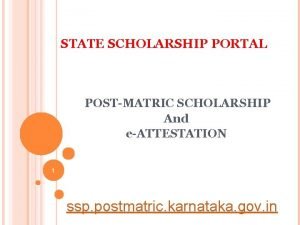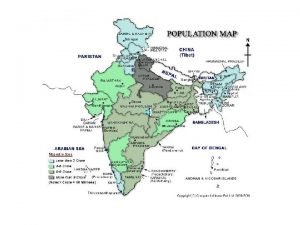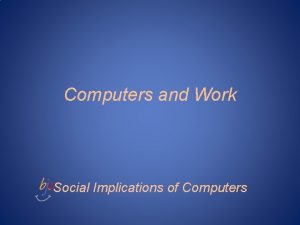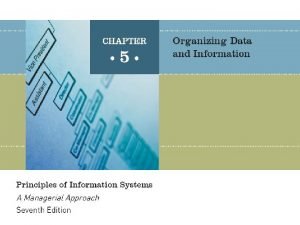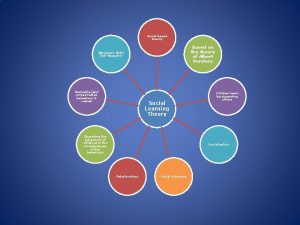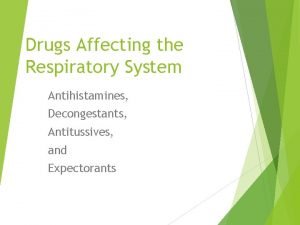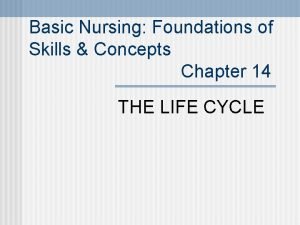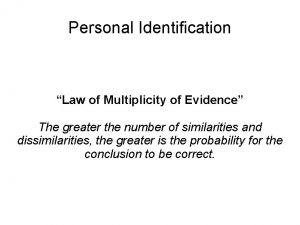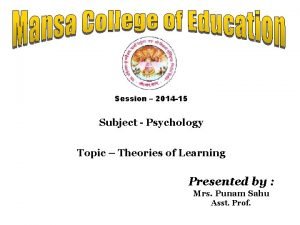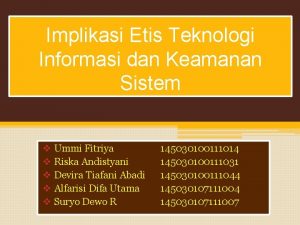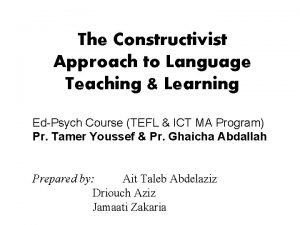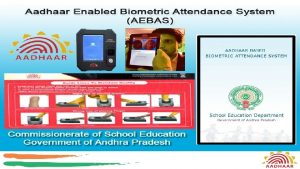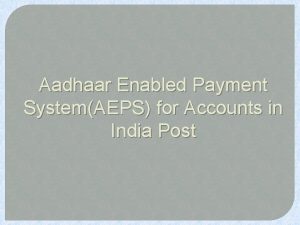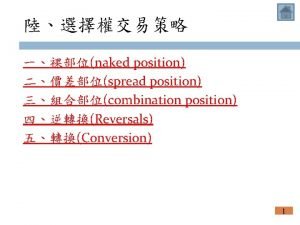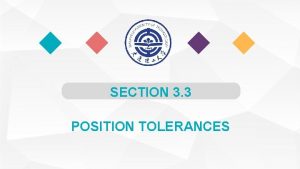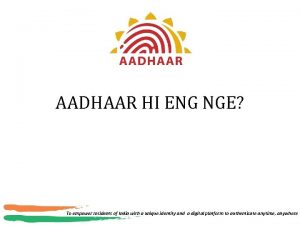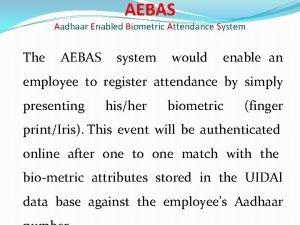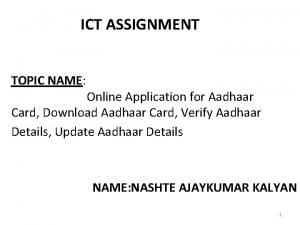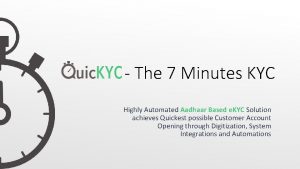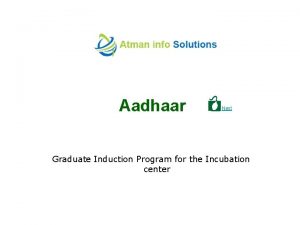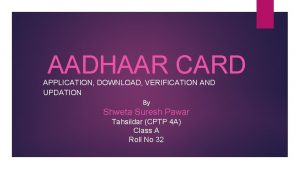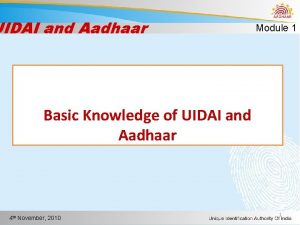Position on implications of Aadhaar in India Disclosure




















- Slides: 20

Position on implications of Aadhaar in India Disclosure: elements of this presentation are adapted from media reports, our ground experiences, and research.

What is Aadhaar? • “To provide for good governance, efficient, transparent and targeted delivery of subsidies, benefits and services, the expenditure for which is incurred from the Consolidated Fund of India, to individuals residing in India through assigning of unique identity numbers. ” – UIDAI website

What is Aadhaar? • “Aadhaar number is a 12 -digit random number issued by the UIDAI (“Authority”) to the residents of India after satisfying the verification process laid down by the Authority. ” • “Aadhaar is a strategic policy tool for social and financial inclusion, public sector delivery reforms, managing fiscal budgets, increase convenience and promote hasslefree people-centric governance. Aadhaar can be used as a permanent Financial Address and facilitates financial inclusion of the underprivileged and weaker sections of the society and is therefore a tool of distributive justice and equality”

What is the problem? State governments not following SC orders “In October 2015, the Supreme Court ruled that the use of Aadhaar, India's biometric-based identity number for residents, to access public benefits like pensions and provident fund was voluntary, not mandatory. But the Rajasthan government started the process of seeding or linking the Aadhaar numbers of all pension beneficiaries to bank accounts in March of that year. ” (https: //scroll. in/article/813132/rajasthans-living-dead-thousands-of-pensioners-wit hout-aadhaar-or-bank-accounts-struck-off-lists) Those without Aadhaar or bank accounts were struck off the pension list and declared dead

Implications 1. Social exclusion 2. Economic implications 3. Implementation challenges & the existing loopholes 4. Data protection and social exclusion

Infrastructure problems • Jyothi Alamadamu (Gollaprolu Mandal), a tribal resident of the Sweeper Colony in Andhra Pradesh, works as a maid. In her blog, Reetika Khera had shared the story of this women whose threeyear old twins were starving because the e-POS did not recognise her biometric or identify her ration card number. In her blog, Khera quotes an angry villager: “There is no point of giving Rs. 1 per kg rice and Rs. 2 per kg wheat if the poor has to forego Rs. 250 of their wage, excluding the cost of transportation, in the bargain. ” 1. Digital devices 2. Internet connectivity 3. Database syncing 4. Digital infrastructure

Leading to Social exclusion Poor delivery of Aadhaar scheme has led to: • Denial of Civil Rights - People cannot access rations, pensions, wages - HIV patients, transgenders cannot access medical services without Aadhaar (http: //www. livemint. com/Politics/y. Vi 0 Yz 2 n 6 z. VLzyw. MFq 38 CK/Aadhaar-sparks-debate-over-humanright-to-personal-data. html ) • No synchronisation of government databases - Therefore duplication of databases. States like Rajasthan and AP have their own IDs linked to PDS • No clarity between SC, central government or state governments, RBI

Aadhaar has become Mandatory and Coercive



Policy Challenges • Neero Devi, a mother of a 30 -year-old 60% disabled son, Raj Kumar, lives in Rajawala village, 20 kilometers away from the Dehradun city, capital of Uttarakhand. She lays down two crisp 500 rupee notes on the floor of her one-room house and says, this is what she has to last her the entire month. The 62 -year-old widow’s son has been rendered immobile due to his disability, unable to speak or move. She says, “We were heavily dependent on the monthly disability pension which we get for my son from the government. It has stopped since last year in October since he doesn’t have an Aadhaar Card. ”

Policy Challenges • Started as plug to stop leakages in the system. Of the 7 major Aadhaar linked welfare schemes (PDS, NREGA, ICDS, LPG, fertilizer subsidy, IAY, Pension Scheme, Janani suraksha yojna etc. ), only DBTL has been cited as a success story, saving Rs 15000 crore. On close scrutiny, this claim is misleading. According to CAG, the fall in oil prices account for 92% of the savings attributed to DBTL. • No provision for differently abled people who are unable to use Aadhaar linked schemes • Denial of financial inclusion schemes such as Pension or MNREGA or fertilizer subsidies

Policy Challenges • Duplication of authentication and enrolling services lead to increasing the cost of enrollment of citizens. For example - both UIDAI and NPR are entrusted with the job of enrolling residents and collection of their biometric details. Presently, UIDAI collects data from 24 states/UTs. NPR collects from 12 states/UTs. Where NPR handles enrolments, they get from UIDAI. Protection of data is not covered by Aadhaar Act. This is a clear violation of Aadhaar Act.

Implementation Challenge • In case of collecting biometric for differently abled people, officials have reiterated that they were “helpless”. Anurag Shankhdhar, district social welfare official (Dehradun), said, “A proposal was floated to visit severely disabled and old people at home to collect their biometrics, but we are yet to receive machines for the exercise from the government. ” • 11 year old - Santoshi Kumari, living in Karimati village of Simdega district in Jharkhand died due to the lack of access to available food. Santoshi’s family visited the ration shop, the database on the local computer refused to recognise Santoshi’s family as one enrolled under the PDS. Even after several attempts, that stretched over more than half a year, the Aadhaar and PDS details could not be matched on the system despite various layers of identification recorded—name, address, UID, finger print and even iris scan.

Implementation Challenge • Technical issues like biometrics not being accepted, validations unsuccessful have led to many being turned away from the rations etc that they need so badly. • Biometric mismatches of genuine beneficiaries when their fingerprints no longer match with what is recorded on the central database

Aadhaar and Data Protection • What is Personal Data? OECD countries recognise the following as Sensitive Personal Information - Health, Genetic, Financial, Ethnic, Racial, Religious belief, Sexual orientation Government of India recognises the following as SPI -Passwords, Financial information such as Bank account or credit card or debit card or other payment instrument details, Physical, physiological and mental health condition, Sexual orientation, Medical records and history and Biometric information

Aadhaar and Data Protection • Risk is unalterable: Biometric information cannot be changed. Unlike passwords which can be changed if compromised, biometric information remains the same. It is important that when biometric information is collected it stored in a high secure database and protected. • UIDAI has faced trouble collecting biometric information, authenticating it, and recognising customer details.

Data Protection and misuse of data • Case 1: Airtel Payment Banks were activated without the informed consent of customers when Aadhaar linked KYC was used. LPG subsidies were deposited into these accounts without customers’ knowledge (https: //timesofindiatimes. com/business/india-business/rs-167 cr-deposited-in- airtel-bank-without-consent-of-31 l-users/articleshow/62111310. cms) Customer data was not secure and private service providers used Aadhaar details without consent of customers.

Data Protection Act • The Data Protection White Paper states that the processing of personal information will be informed by 3 principles 1. Limitation 2. Purpose specification 3. Storage limitation • Both Aadhaar Act and Data Protection White Paper mention use limitation and purpose specification, however, there have been cases of private service providers over reaching. • Agencies approved by government to collect sensitive personal information have been found to have links to security companies in the USA. Indian citizens’ data is not safe. This brings us to the question of Jurisdiction – neither acts are robust enough to protect citizens. Rectify to protect citizens

Possible Solutions 1. Allow for longer gestation period before enforcing Aadhaar linked rations and services. 2. Conduct trials and phase by phase roll out so infrastructural and technical issues can be addressed. 3. Aadhaar Act must address accountability of UIDAI in case of data breaches. Currently UIDAI does not have to disclose breaches to users. 4. Data Protection Act must address gaps in security that Aadhaar Act fails to address. Must protect citizens from foreign laws 5. Validity and acceptance of Aadhaar as a valid document needs to be assured. Even if Aadhaar exists, checkers ask for other document like voter card. In that case the very purpose of Aadhar identity is defeated. Is Aadhaar a one man one national identity? in that case will every citizen will get equal importance and respect? 6. The objectives, awareness and real good intentions of Aadhaar has still not reached the people. The messages and communications have been not symmetric and has created confusion and doubts.
 Esign.ssp.karnataka.gov.in
Esign.ssp.karnataka.gov.in Second position echappe
Second position echappe Geographical position has given india
Geographical position has given india Medical implications of developmental biology
Medical implications of developmental biology Tautological implications
Tautological implications Legal implications in nursing practice
Legal implications in nursing practice Social implications of computers
Social implications of computers Database approach to data management
Database approach to data management Educational implications examples
Educational implications examples Benzonatate nursing implications
Benzonatate nursing implications Nursing implications
Nursing implications Father of personal identification.
Father of personal identification. Educational implications of operant conditioning
Educational implications of operant conditioning Implikasi etis dari teknologi informasi
Implikasi etis dari teknologi informasi Example of proposition in math
Example of proposition in math Dromotropic effect
Dromotropic effect Chapter 23 legal implications in nursing practice
Chapter 23 legal implications in nursing practice Social constructivist meaning
Social constructivist meaning Legal implications of social media
Legal implications of social media Flucytosine mechanism of action
Flucytosine mechanism of action How audience negotiate meaning in mil
How audience negotiate meaning in mil
